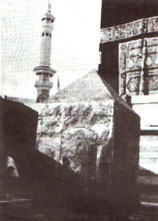Qur’an in Sura Baqra Verses 121 to 127 described it clearly that Allah had ordained his servant Ibrahim to build the Shrine there for worship of One God. During Kusayi’s time it was rebuilt and fortified. During the early years of Prophet Muhammad (SA) before he announced his ministry, the Ka’aba was damaged by floods and it was rebuilt again. When the Black stone was to be put in its place the Makkans quarrelled among themselves as to who should have the honour to place it there. They had just decided that the first comer to the quadrangle should be given the task of deciding as to who should have the honour. Muhammad (SA) came in and was assigned this task. He advised them to place the stone in a cloak and ordered the heads of each Tribe each to take an end and bring the cloak nearer the corner on the eastern side. He himself then took out the stone and placed it in its position. It has been fixed there ever since.
After the martyrdom of the family of the Prophet at Kerbala in 61 Hijri (681 AD), the Ummayad Caliph Yazid Ibne Moawiya did not stop there in the pursuit of his destruction. He sent a large contingent under the command of Haseen Ibne Namir to Madina which destroyed the Mosque of the Prophet. They did not stop there but proceeded to Makka and demolished the four walls of the Ka’aba and killed thousands of muslims who protested. Yazid died and Ibne Namir returned to Damascus, Ka’aba was rebuilt by Abdullah Ibne Zubayr and his associates. Umawi forces came back to Makka and killed Abdullah Ibne Zubayr, hung his body on the gates of the Ka’aba for three months for all to see the Umawi power. But eventually this arrogance of power brought its own consequences and Mukhtar became the ruler in Iraq. Under his guidance the Ka’aba was refurbished and pilgrims began to arrive in safety to perform Hajj.
The Ka’aba successfully withstood the Karamatian invasion of 317/929, only the Blackstone was carried away which was returned some twenty years later. In the year 1981 the Wahabis brought tanks inside the Ka’aba to crush the kahtani revolution against the Saudi regime and almost demolished the South Eastern Wall. This was later restored with the help of the Makkan people.
Every man living in Makka in the 6th and 7th century must out of necessity have had some relationship with the Ka’aba. On the Muhammad (SA), the Prophet of Islam, the Qur’an is silent during the Makkans period in this respect. All that is known is that the muslim community of the period turned towards Jerusalem in prayers. Subsequently about a year and a half after the Hijra the Muslims were ordered during prayers which were lead by the Prophet of Islam himself to turn towards Makka. The particular mosque in Madina where this happened is called Masjide Qiblatain, meaning the mosque with two Qiblas.The Qur’an tells the muslims, “ turn then thy face towards the sacred mosque and wherever ye be turn your faces towards that part ”Qur’an II,139/144.
At this same period the Qur’an began to lay stress on the religion of Ibrahim, presenting Islam as a return to the purity of the religion of Ibrahim which, obscured by Judaism and Christianity, shone forth in its original brightness in the Qur’an. The pilgrimage’s to the Ka’aba and ritual progressions around the building were continued, but were now for the glorification of One God. The Abrahimic vision of the Ka’aba created a means of discerning an orthodox origin buried in the midst of pagan malpractices to which the first muslims pointed the way.
Every year after the Hajj ceremony the place is closed for one month and on the Day of Ashura the Ka’aba is washed from inside by the Water from the well of Zamzam and a new Kiswa is brought to cover the Ka’aba for the next year.
This is the story of the Ka’aba and the persons who protected it and remained its custodians and protectors from the satanic and evil forces throughout history. Muhammad (SA) and the people of his household (Ahlulbayt) were the protectors of the Ka’aba, and currently the 12th Imam from the direct descent of the Prophet of Islam is the real protector, its custodian and guardian and shall remain as such while in concealment. In the following pages we shall unfold the lives and times of these 14 Masoomeen Alaihimussalam.















